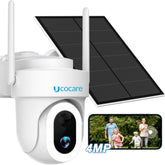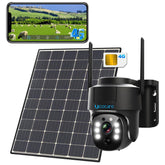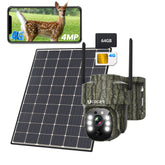Components and Working Principles of Surveillance Cameras
Surveillance cameras have become crucial tools for ensuring safety and preventing crime. Whether in commercial areas, public spaces, or homes, surveillance cameras are ubiquitous. But how do they work, and what are their components? Let's uncover the mystery of surveillance cameras.
Components of Surveillance Cameras
To understand how surveillance cameras work, we first need to know what they are made of. A typical surveillance camera consists of several key parts:
1. Lens:
This is the "eye" of the camera. The lens captures light and focuses it onto the image sensor. The quality of the lens directly affects the clarity of the image. Depending on the application, lenses can vary, such as fixed-focus lenses and zoom lenses.
2. Image Sensor:
This is the core component of the camera, with two main types: CCD (Charge-Coupled Device) and CMOS (Complementary Metal-Oxide-Semiconductor). The image sensor converts light signals into electrical signals, which are then sent to the processing unit.

3. Processor:
The processor converts the electrical signals captured by the image sensor into digital images that can be stored or transmitted. Modern cameras often have built-in image processing algorithms that handle tasks like image compression, noise reduction, and color correction.
4. Storage Device:
This is where recordings are saved. There are two main types: built-in storage and external storage. Built-in storage has limited capacity, suitable for short-term recording. External storage can be an SD card, hard drive, or cloud storage, offering greater capacity for long-term recording.
5. Power Supply:
Cameras need power to operate, typically provided by a power adapter. Some advanced cameras can also use Power over Ethernet (PoE), which is both convenient and tidy.
6. Housing:
The housing protects the internal components. Outdoor cameras especially need to be waterproof, dustproof, and vandal-resistant.
7. Network Module:
Modern surveillance cameras often come with networking capabilities, transmitting images to a monitoring center or the cloud via wired or wireless networks, facilitating real-time monitoring and remote viewing.
How Surveillance Cameras Work
Now that we know the components, let's see how a surveillance camera works:
1. Light Enters the Lens
The camera lens captures light from the environment. The lens focuses this light to form a clear image on the image sensor.
2. Image Sensor Converts Light Signals
When light reaches the image sensor, it converts the light signals into electrical signals. Both CCD and CMOS sensors perform this conversion, albeit through slightly different mechanisms.

You still need to understand the difference between CCD infrared and CMOS infrared:
CMOS production process is simpler than CCD, CMOS price is cheaper than CCD, CMOS consumes more power than CCD, CMOS noise points are larger than CCD, CMOS sensitivity is worse than CCD, and CMOS resolution is lower than CCD.
3. Processor Handles Image Signals
The electrical signals from the image sensor are sent to the camera's processor. The processor processes these signals, including tasks like image compression, noise reduction, and color correction. This ensures that the final image is clear and takes up less storage space.
4. Image Storage and Transmission
Processed images can be stored in the built-in storage device or transmitted in real-time to a monitoring center or cloud storage via the network module. Real-time images can be displayed on monitoring screens or viewed remotely on mobile devices.
5. Power Supply and Monitoring
A stable power supply is essential for continuous camera operation. Power adapters or PoE provide the necessary power. Monitoring systems can control the camera through software, adjusting angles, zoom, recording times, and more.
Features of Different Types of Surveillance Cameras
There are various types of surveillance cameras on the market, each suited for different scenarios and needs. Common types include:
1. Analog Cameras
Traditional analog cameras transmit video signals in an analog format to a monitoring system, usually requiring special video cables and recorders. Though the image quality is lower than digital cameras, they are cost-effective for small-scale monitoring.
2. Network Cameras (IP Cameras)
These cameras digitize video signals and transmit them over a network. They offer high image quality, facilitate remote monitoring and management, and are widely used in various settings.

3. Wireless Cameras
Wireless cameras transmit video signals via Wi-Fi or other wireless technologies. They are flexible to install and do not require wiring, making them ideal for homes and small businesses.
4. Infrared Cameras
Equipped with infrared emitters, these cameras can operate in low-light or no-light conditions, making them suitable for night monitoring and low-light environments.
5. Panoramic Cameras
Using multiple lenses or fisheye lenses, these cameras capture wide-angle images, covering larger areas and reducing blind spots. They are suitable for large-scale monitoring needs.
Applications of Surveillance Cameras
The applications of surveillance cameras are vast, ranging from public safety to home security.
1. Public Safety
In city streets, public transportation, airports, and train stations, surveillance cameras help prevent crime and maintain public order. The recorded footage can serve as evidence to aid police investigations.
2. Commercial Places
In malls, supermarkets, offices, and other commercial places, surveillance cameras help prevent theft, fraud, and monitor employee behavior, enhancing security and management efficiency.
3. Home Security
Home surveillance cameras protect against theft, monitor children and pets, and ensure the safety of the elderly. Remote viewing features allow users to check on their homes anytime, even when away.
4. Traffic Management
At intersections and highways, surveillance cameras monitor traffic flow, record traffic violations, and help traffic management departments maintain order.
Future Trends
As technology advances, surveillance cameras continue to evolve. Here are some future trends:
-
Artificial Intelligence and Machine Learning:
Future cameras will be more intelligent, featuring facial recognition, behavior analysis, and anomaly detection, enhancing security and management efficiency.
-
High Definition and Ultra High Definition:
Image resolution will continue to improve, from HD to 4K, and even 8K, providing clearer image details for better recognition and analysis.
-
Edge Computing
Cameras will have more processing power, allowing for local data processing and analysis, reducing reliance on the cloud, and improving response speed and data security.
-
Internet of Things (IoT)
Surveillance cameras will connect with other smart devices, forming a comprehensive security and management system for more efficient collaboration.
By understanding the components and working principles of surveillance cameras, we can better utilize this technology to enhance safety and management efficiency. Whether for public safety, commercial places, or home security, surveillance cameras are indispensable tools. As technology continues to advance, surveillance cameras will play an even more critical role in the future.











